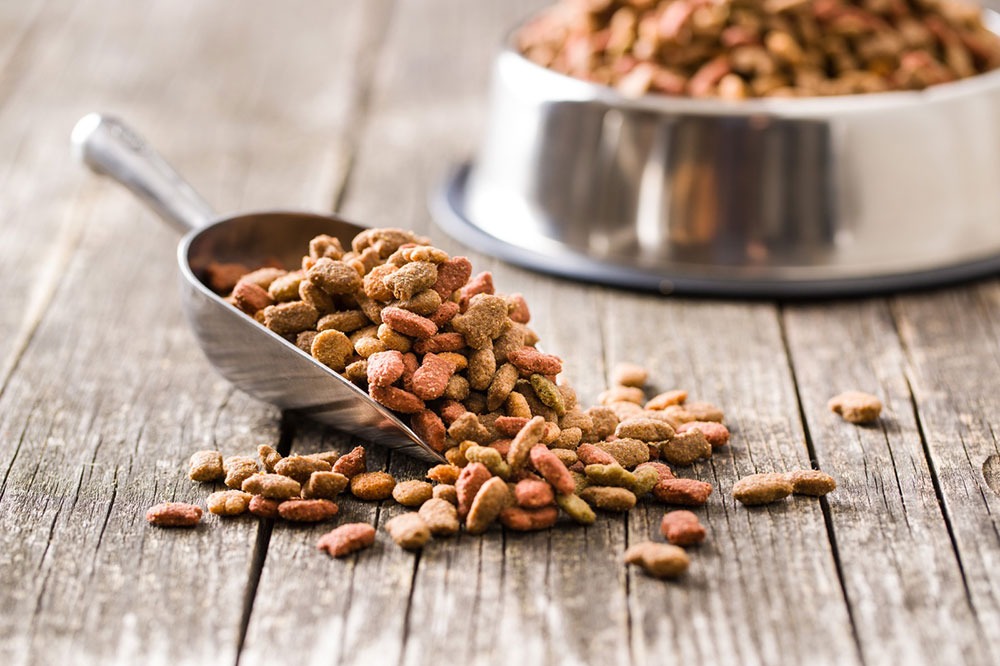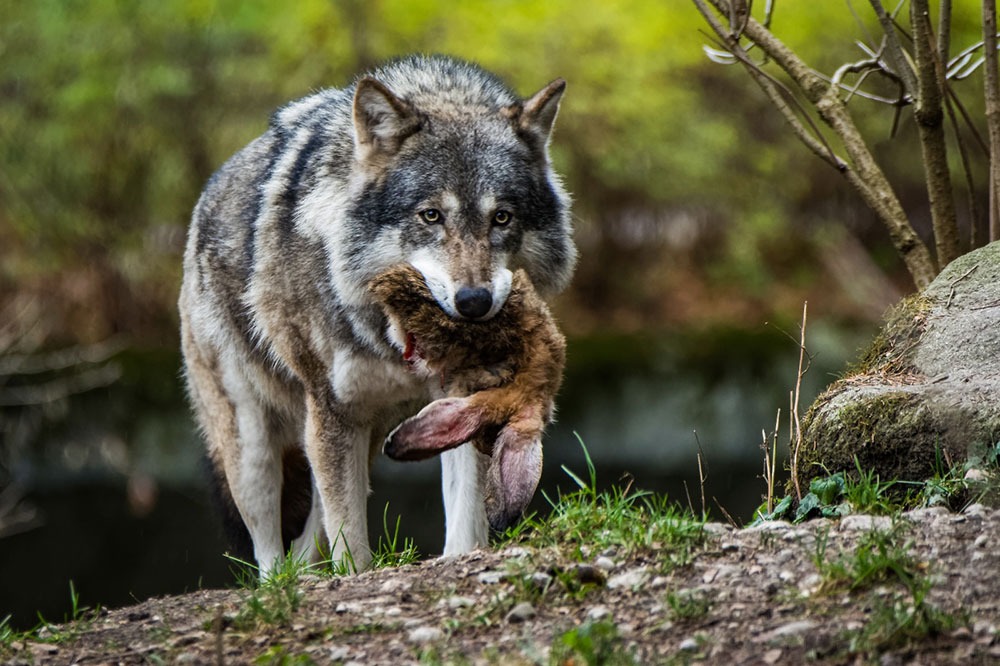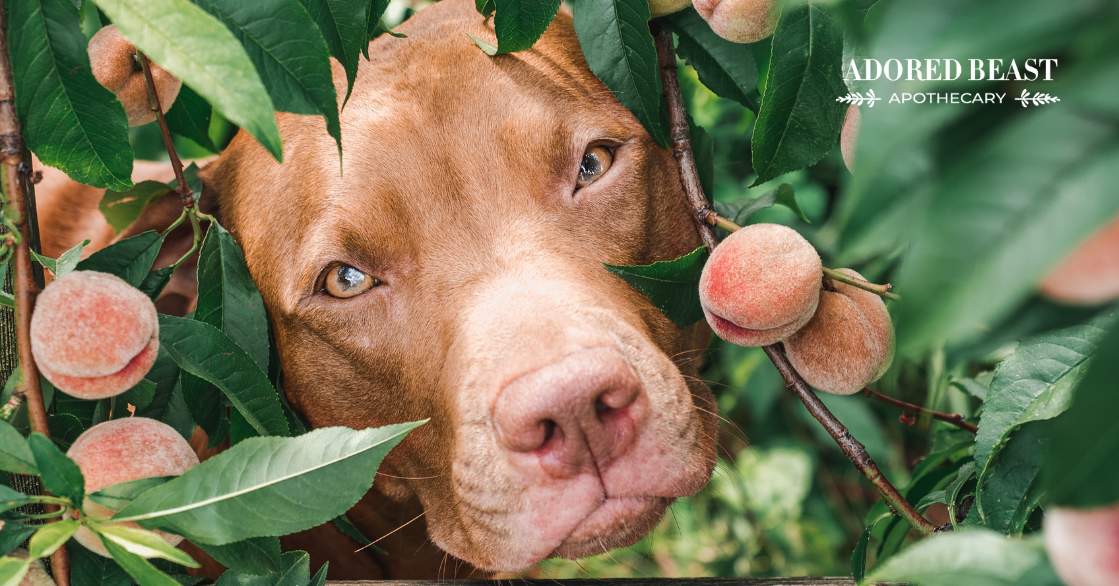There’s a great debate about dog nutrition among pet parents, animal care professionals, and pet food companies. Some believe dogs should be eating whole prey. Others believe they should have vegetables in their diet. There’s also the vegetarian or grain-free routes. So what in the world should our dogs really be eating?
If you follow me, you’ll know I’m borderline obsessed with studying the origin of species. Whenever I want to learn what to feed an animal that’s in my care, I look to what they eat in nature or, in the case of domestic species, I look to their closest living wild ancestors. Once I identify the species that’s the closest genetic match, I research their feeding behaviours in nature. I then use this information along with AAFCO/NRC guidelines to piece together the most species-appropriate foods and feeding schedule for that species.
In this article, we are going to get down to the bottom of what foods are appropriate for dogs and how to effectively feed them for optimal health and longevity.
Dog Nutrition: An Ancestral Diet?
It’s estimated that dogs were domesticated from wolves 30-40, 000 years ago. (1) Their social nature and ability to cooperate with each other allowed them to naturally find a place in our human world. Humans are social animals, just like dogs, and the two species have a symbiotic relationship. Canids were able to assist with tracking prey with their superior senses and they most likely were an early danger warning system within human camps. Wolves got the benefits of strength in numbers, more successful hunts and human social interactions. The partnership increased chances of survival for both species. (2)
In 1993, the domestic dog, called Canis familiarus had its classification changed to Canis lupus familirus, a subspecies of the wolf rather than its own species. This was decided after Dr. Robert Wayne’s genetics study was published finding the DNA of wolves and dogs so closely matched that they had to be the same species. (3)
In the modern world, dogs may be bred to have a number of colors, shapes, sizes and coat lengths, but their ancestry remains. Over the past 100 years, processed feeds have become “normal” dog nutrition. We’ve forgotten that before this, dogs were still fed off the farm and, before that, from the hunt and foraging for other foods in nature. As humans moved away from rural life, we took our dogs with us into a synthetic society with synthetic ways of living, including food.
Today’s pet food industry has gone so off-course that it’s hard comprehend how we got here. People have traded the ancestral diet of dogs for convenience and believe that the food being offered on the market is scientifically proven to be what’s best for their dogs. Even the most trusted animal professionals, our veterinarians, have been roped into believing this absurd concept. It is widely taught in vet school that processed diets are the one and only way to feed dogs, even going so far as to say that fresh food is dangerous. Keep in mind that the veterinary industry is the ONLY medical profession that recommends processed feed over fresh food. Veterinary school also teaches vets that fresh food is dangerous…
The history behind how this happened is subject for a different day, but for now, I’d like to mention that there is a growing community of vets who have stepped outside of this box and started doing their own research for the sake of their patients.
“Feed” Vs. “Food”
Feed: Processed feed is a blend of various raw materials, waste materials, and additives. Ingredient sources for animal feed may include household food scraps and waste by-products from industries including meat, milling, and brewing. Manufacturers formulate it into rations, process it with high heat, and form it into pellets, meals, or crumbles.
Feeds are formulated according to the specific known requirements of the target animal. The nutritional requirements for each species are dictated in the USA and Canada by the American Association of Feed Control Officials or AAFCO.
Some of the most common animal feed stuffs include grains like:
- wheat
- corn
- soy
- oats
- barley
- sorghum (and, yes, they use a lot of grains in dog feed).
Often times, they aren’t even whole grains, only by-products.
And, to add insult to injury, these feed stuffs can be full of dangerous moulds (aphlatoxins) and the dangerous herbicide known as Round-Up (glyphosate). Meat sources for animal feed often fall under the category of by-products or meal which isn’t anywhere close to resembling whole prey. The foodstuffs are rendered at high temperatures before being cooled and mixed with synthetic vitamin/mineral premix. These premixes contain (to the best of our knowledge) nutrients lost in the rendering process and nutrients that just never existed in the ingredients. Premixes may also contain chemical preservatives, taste enhancers and colorants, some classified as known carcinogens.
No matter how much we think we know, we cannot deconstruct nature and think we can put it together again in one piece. We humans are great at justifying our actions but the pet food industry has some massive and glaring problems that we need to question with logic.

The Definition of Food
Food is any substance in nature that serves as a source of nutrition for animals or plants to sustain life and growth. In nature, nothing is rendered, extruded or synthesised. It is never pulled apart and stuck back together like some type of nutritional Frankenstein. The puzzle pieces are all there, occurring in their natural and unaltered form, ready to be used as food for the species that seeks it out.
As cows naturally seek out grass, dogs naturally seek out meat. Notice how your dog stares at your plate and drools next time you’re eating some. We don’t call grass “cow food” because it’s food for a variety of animals all over the planet. It is simply a source of food for those animals that evolved to eat it. Although a bear is classified as an omnivore, it doesn’t recognize grass as a staple of its diet, only a piece of it. Even if it did eat it as a main food source, it would not sustain them because their cells cannot obtain all required nutrients from it. This is determined by genetics. The same goes for dogs.
We need to look at canine ancestry to learn how they cover their nutrient requirements in nature.

There is no such thing as “dog food.” There is only food. And which types of food are appropriate for each species is determined by their ancestry. This is not an idealistic concept. It is science. When we are looking for optimal nutrition of a species, we need to look at their most closely related wild ancestors to determine the best foods for them. The debate rages on about whether dogs are carnivores or omnivores but classification is less important than studying what wolves actually eat. Our idealism has become more important than looking at what’s actually going on in nature.
I look at dogs as opportunistic carnivores. Let’s take a look at the feeding behaviours of wild wolves for a more in-depth explanation of what I mean by that.
The True Science of Dog Nutrition
Dogs are in the family Carnivora. This is the family of animals whose main diet consists of prey. Some carnivores are omnivorous like the wolf and the bear but they naturally seek out prey to sustain themselves. Wolves are a well-studied species in all areas of the world and we can use their natural feeding behaviours to learn how to give our dogs the ultimate canine diet.
The study of metagenomics is a branch of science that explores how environment shapes genetics. The environment determines the type of food an animal has access to and has a huge role on the evolution of a species.
Nutrigenomics is another fascinating field of science that studies how nutrition affects gene expression. We can learn so much about how to feed dogs correctly from this kind of research along with the massive body of field research available on wolves. Pet food research is much less promising when it comes to finding true answers because funding is often provided by the pet food companies themselves. If you want to find real science on animal nutrition, you need to look for independent studies in your search for the answers. There are some studies of this nature for how fresh food benefits dogs including the Dog Risk Project and Long Living Pets. And, we can look to wolves.
Feeding Ecology of Wolves
Wolves have unique feeding habits. They can teach us so much about how to care for our own dogs. One thing to remember about wolves is that they are opportunistic. They are survivors that can adapt to what foods the environment offers. Wolves are highly intelligent which allows them to adjust and innovate on the day. Below is a summary of the feeding ecology of wolves.
Though dogs have the ability to be omnivorous, they gravitate to fully carnivorous behaviour whenever it is possible. One 5 year study showed exactly that: when large (ungulate) prey is abundant, it makes up 80-90% of their diet. But when availability was low, they were able to fill the void with smaller prey supplemented with fruits and vegetables. (4) The diet still consisted of 70% large prey in those situations. Another study at Yellowstone National Park showed that the primary choice of prey was elk even though other ungulates roam the park. (5) They will live entirely on elk when given the choice. There are more studies on wild canid feeding behaviour and prey nutrient composition which paved the way to create the nutritional analyses of the ancestral dog diet. (6) (7) (8)
Studying wolf ecology, we can see their seasonal feeding behaviours. This is my go-to for understanding how to optimize the raw diet for our domestic dogs. There is no pet nutrition science that speaks louder to me than these studies. Independant science is the most honest attempt at finding the true nutritional requirements of dogs. The biologists studied the outcome of natural processes with no personal agenda on animals that have no concept of our human priorities. Science of this calibre gives us an undisturbed look at the truths of dog nutrition.
Some of the highlights of the wolf studies:
- Seasonal adaptation of the diet was significant. Wolves primarily eat large prey (elk) in the winter time since large prey will keep in the cold temperatures if the whole carcass is not consumed immediately. During the summer months, they consume some smaller prey including birds, rabbits, rodents, insects and ungulates not consumed at all during the winter months.
- Immediately after killing their prey, the wolves will eat the viscera first including the intestines, heart, lung, liver, spleen and kidneys. It seems to be intuitive that these parts have the highest nutritional value.
- Interestingly, wolves don’t consume the stomach, only the intestines, where plant matter has already been digested.
- Wolves consume everything else except the hard femur bones and some of the hide.
- In the fall in British Columbia, Canada, wolves take a break from hunting large game to part take in the salmon run, gorging themselves on fish and fish roe. This is also when the elk and other large game are at their peak body condition and harder to take down after being well-fed over the summer months.
The main takeaway from this is that wolves have a very targeted diet in nature. They are naturally drawn to nutrient-dense prey-based foods. If you want to ensure that your dog lives his best life, you must take this science into consideration. Humans physically cannot create a better diet than this.
The Problem with Dog Feed
For me, the concept of dog nutrition, in conventional or scientific terms, has lost its meaning. Your doctor will tell you to stay away from packaged food and eat as much fresh food as possible but your vet will tell you the exact opposite is true for your dog. Why do we need so much science to justify fresh food? There are a lot of political and economic reasons for this, subject for another day. For now, let’s talk about AAFCO.
Dog feed is formulated as per the American Association of Feed Control Officials (AAFCO). While AAFCO guidelines can give us clues to help us feed our animals, it isn’t going to help if we’re looking for optimal nutrition. The problem with AAFCO is threefold:
- Most AAFCO nutrient requirements are based on the minimum amount required to avoid nutritional deficiency, not optimal levels for health.
- AAFCO doesn’t recognize the difference between naturally occurring nutrients vs. synthetic ones. It also doesn’t recognize some nutrients at all eg. enzymes, phytonutrients and some fatty acids (DHA & EPA).
- Ingredients approved by AAFCO to be used in dog feed can include waste products: low quality, inedible or not fit for human consumption. Eg. The following ingredients are considered acceptable in dog feed: corn starch, meat and grain by-products, peanut hulls, soy bean hulls, old restaurant grease, and other ingredients that might make you feel a bit ill.
AAFCO can help us find a starting place but it isn’t the holy grail of animal nutrition. Fresh foods have gotten a bad reputation for being dangerous to feed to animals but processed feed has its own dangers. Some of the scariest FDA pet food recalls that happen each year are processed pet feeds: eg. the accidental overdosing of fat-soluble vitamins leading to death (eg. vitamin D), aphlatoxins, mycotoxins (from rotten grain products) and, yes, even salmonella and e. coli which raw pet foods have been unfairly singled out for. (9)
Comparing AAFCO to the Ancestral Diet
The canine ancestral diet has now been established by world-renowned diet formulator, Steve Brown, author of ‘Unlocking the Canine Ancestral Diet.’ His data is based on the ecological studies. Thanks to Steve’s research, we have a deeper understanding of what the ancestral diet of dogs looks like. We are now able to compare the nutritional analysis of the dog’s natural diet to AAFCO’s guidelines. And the differences might shock you:
Macro Nutrients:
| AAFCO ADULT | AAFCO PUPPY | ANCESTRAL* | |
| PROTEIN | 18% | 22.5% | 49% |
| FAT | 5.5% | 8.5% | 44% |
| CARBOHYDRATE | No requirement** | No requirement** | 6% |
*courtesy of ‘Unlocking the Canine Ancestral Diet’ by Steve Brown
** Though there is no AAFCO requirements for carbohydrate for dogs, it makes its way into dog feed at alarmingly high rates… and, is not required to be listed on the bag. Fibre is NOT the same as starch and only fibre is required to be listed on the nutritional analyses.
As you can see, the numbers from AAFCO are pretty lacking in the macros department. But what about vitamins and minerals? Is AAFCO doing any better on this front? The vitamin/mineral data that we have on the ancestral diet is also telling a much different story than AAFCO….
Vitamins and Minerals (per 1000 kcal)
| AAFCO ADULT | AAFCO PUPPY | ANCESTRAL* | |
| Calcium (g) | 1.25 | 3 | 5.7 |
| Phosphorus (g) | 1 | 2.5 | 3.3 |
| Potassium (g) | 1.5 | 1.5 | 2 |
| Sodium (g) | 0.2 | 0.8 | 1 |
| Magnesium (g) | 0.1 | 0.15 | 0.4 |
| Iron (mg) | 10 | 22 | 43 |
| Copper (mg) | 1.83 | 3.1 | 6 |
| Manganese (mg) | 1.25 | 1.8 | 3.1 |
| Zinc (mg) | 20 | 25 | 24 |
| Calcium:Phosphorus | 1:1 | 1:1 | 1.7:1 |
| Vitamin A (IU) | 1250 | 1250 | 15, 000 |
| Vitamin E (IU) | 12.5 | 12.5 | 23 |
*courtesy of ‘Unlocking the Canine Ancestral Diet’ by Steve Brown
You can clearly see that AAFCO falls short on almost all fronts when it comes to nutrition for dogs. Not only does the ancestral diet cover the needs of adults, it is also completely balanced for puppies. So, the next time you hear the term “balanced and complete” or “AAFCO Balanced,” ask yourself: Is AAFCO the only way to quantify what your dog needs?
Dietary Disease
The 3 most prevalent non-infectious chronic diseases in modern dog according to the Banfield Veterinary Report are:
- Obesity
- Dental Disease
- Skin Disease & Ear Infection
What do all of these diseases have in common? They all have a definite nutritional component…. I would even go so far as to say that, in my experience, these are largely nutritional diseases. Over the next several months, I’ll go through each of these in the context of nutrition and unravel the mysteries of why so many dogs are suffering from these illnesses. We’ll also discover what we can do to prevent and improve them with canine-specific nutrition.
So there’s some food for thought. I hope these concepts help you to understand the unique nutritional needs of dogs and I look forward to sharing more with you soon. Thanks for reading!
References:
- Ancient European dog genomes reveal continuity since the Early Neolithic, Nature Communications, 2017
- Influence of Group Size on the Success of Wolves Hunting Bison, PLoS One, 2014
- Molecular Evolution of the Dog Family, Trends in Genetics, 1993
- The feeding habits of wolves in relation to large prey availability in northern Italy, Ecography, 1996
- Foraging and Feeding Ecology of the Gray Wolf (Canis lupus): Lessons from Yellowstone National Park, Wyoming, USA, The Journal of Nutrition, 2006
- Food Habits of Feral Carnivores: A review of Stomach Content Analysis, Journal of the American Animal Hospital Association, 1979
- Spawning salmon disrupt trophic coupling between wolves and ungulate prey in coastal British Columbia, BCM Ecology, 2008
- Nutrient Composition of Whole Vertebrate Prey (Excluding Fish) Fed in Zoos, Cornell University, 2002
- FDA Veterinary Recalls and Withdrawals Database












